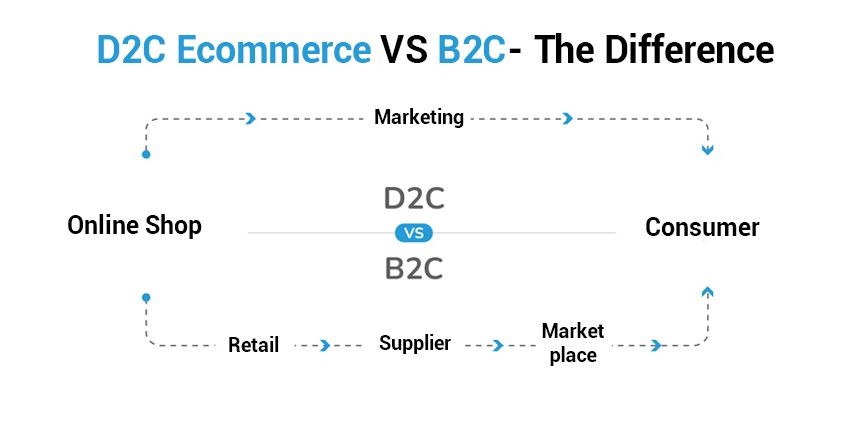

Jun 28, 2023
558
Are you an owner of an online store seeking to increase sales and optimize your business's operations? In such a case, you might have heard of the words D2C and B2C. However, what do these abbreviations actually signify, and how might they affect your company? D2C also known as Direct-to-consumer has become a game-changer in the e-commerce sector due to the growth of online purchasing and shifting consumer preferences. D2C e-commerce can offer a more individualized purchasing experience, forge closer ties with their target market, and ultimately boost revenue by eliminating the middleman and conducting business directly with consumers. Join us as we explore the benefits of D2C and how it has changed the corporate scene in the digital age today.
D2C E-commerce VS B2C Ecommerce – THE DIFFERENCE

Understanding the key distinctions between D2C and B2C is crucial before exploring the benefits of the D2C e-commerce model. In the Business-to-consumer ( B2C) model, businesses offer their goods or services directly to customers through a variety of channels, including brick-and-mortar stores, internet marketplaces, and distributors. D2C, on the other hand, is a relatively new strategy that enables businesses to sell directly to end users through their own web platforms, cutting out middlemen. The degree of control that brands have over the customer experience is one of the fundamental differences between the two. Brands have little influence over how their products are presented and sold to customers when using the B2C model because they depend on independent retailers or marketplaces to sell their goods. D2C companies, on the other hand, fully control every step of the customer journey, from the layout and branding of their website to product packing and delivery. D2C brands may design a seamless and unified purchasing experience that is suited to the tastes of their target audience thanks to this degree of control.
The interaction between brands and customers is a key dissimilarity between the popular business models. Because they rely on retailers to conduct customer care and support, brands in the B2C model frequently have little direct contact with their customers. This might make it difficult for brands to establish trusting bonds with their target market and get insightful feedback. D2C brands have the chance to build genuine and direct relationships with their customers. Also, they can obtain insightful information, develop customer loyalty, and foster a sense of community around their products by interacting with consumers through social media, tailored email marketing, and other channels. The B2C strategies for the ecommerce model are not as beneficial as D2C, as it presents a more direct and individualized method of product sales. Moreover, the firms may increase sales by eliminating the intermediary and taking charge of the customer experience. By doing so, they can forge stronger bonds with their customers and collect insightful feedback.
Advantages of the D2C model

Let's focus on the benefits of the D2C e-commerce model now that we understand the difference between D2C and B2C. For starters, D2C has many benefits, one of which is the opportunity to provide a more specialized shopping experience. Direct-to-consumer (D2C) businesses are able to collect useful information about the preferences, purchasing patterns, and demographics of their clients. Personalized recommendations, focused marketing initiatives, and specialized product offerings can all be made using this data. This degree of customization improves the consumer experience while also raising the likelihood of repeat business and brand loyalty. The D2C approach has the advantage of allowing for margin and price management. Brands frequently have to sell their products to retailers in the B2C model at wholesale pricing, who then mark them up to pay their own expenses and profit margins. Brands may see lower profit margins as a result of this. D2C ecommerce brands, in contrast, have complete control over their profit margins and the ability to establish their own prices. D2C brands may provide competitive prices to clients while still keeping good profit margins by reaching directly to them.
The famous business model, approach additionally enables brands to receive direct client feedback. Brands have little insight into how their products are perceived by consumers under the conventional B2C paradigm. Brands can obtain direct input from consumers by using social media interactions, questionnaires, and customer reviews. Based on client demand, this feedback can be utilized to generate new product offerings, improve customer service, and improve product quality. D2C brands can stay ahead of the competition and provide excellent products and experiences by iterating and improving regularly based on client feedback. The direct-to-consumer (D2C) e-commerce model has a number of benefits, such as a more tailored shopping experience, control over pricing and margins, and easy access to client feedback. D2C brands may stand out in the market, develop trusting relationships with their clients, and promote long-term success making it a superior choice for most of the businesses today.
Strategies for implementing a D2C e-commerce model

If you have decided to implement a D2C e-commerce model for your business, it's important to have a well-thought-out strategy to ensure success. Here are some strategies to consider when transitioning to one of the convenient business models of ecommerce:
Develop a compelling brand story
Your brand story is extremely important in the D2C model for differentiating your company and gaining a following of devoted customers. Create a captivating brand narrative that appeals to your target market and conveys your distinctive value proposition.
Invest in technology
Investments in business strategy and innovation and technology, such as an e-commerce platform, customer relationship management (CRM) software, and analytics tools, are necessary to implement a D2C model. Select a technological stack that supports your company's objectives and provides seamless customer experiences.
Create a seamless shopping experience
Focus on creating a seamless and user-friendly shopping experience for your customers. Optimize your website for mobile devices, streamline the checkout process, and provide multiple payment options to enhance convenience.
Leverage social media and influencer marketing
Use social media platforms to engage with your customers, build brand awareness, and drive traffic to your online store. Collaborate with influencers in your industry to expand your reach and gain credibility.
Personalize your marketing efforts
Leverage customer data to personalize your marketing campaigns and offers. Use email marketing, retargeting ads, and personalized recommendations to deliver relevant and timely messages to your customers.
Provide exceptional customer service
Invest in customer service and support to build trust and loyalty. Offer multiple channels for customer inquiries and provide timely and helpful responses to enhance the customer experience.
By implementing these strategies, you can effectively transition to a D2C model and leverage its advantages to drive growth and success for your business.
Future of D2C Ecommerce in Pakistan
The rise of Direct-to-consumer brands had revolutionized the way businesses reach and engage with consumers. By cutting out middlemen and establishing direct relationships, the D2C brands have successfully disrupted traditional retail models and reshaped the ecommerce landscape. Through their innovative approaches, the brands have prioritized customer experience, personalization and data-driven insights, allowing them to deliver tailored products and services that resonate with their target audience. Due to these points, the brands of today are able to cultivate brand loyalty and grow strong communities in ecommerce market in Pakistan.
